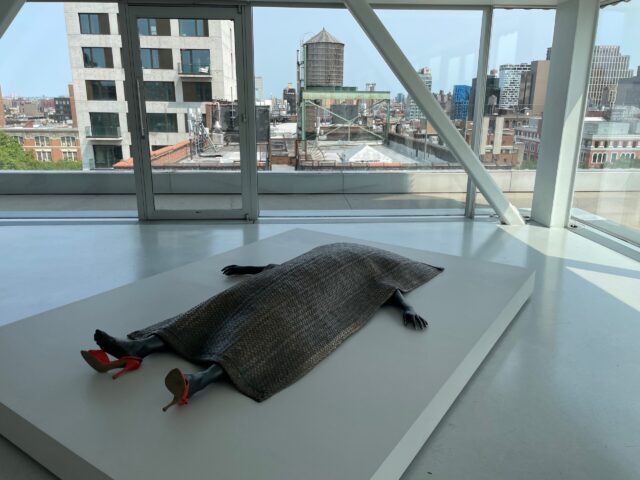
Wangechi Mutu, Shavasana I, bronze, 2019 (photo by twi-ny/mdr)
Who: Wangechi Mutu, Vivian Crockett, Margot Norton
What: Discussion about current exhibition “Wangechi Mutu: Intertwined”
Where: New Museum Theater, New Museum, 235 Bowery at Prince St.
When: Thursday, June 1, $10, 6:30 (exhibition continues through June 4, $12-$18)
Why: In the catalog for “Wangechi Mutu: Intertwined,” cocurators Vivian Crockett and Margot Norton discuss various elements of the exhibit, which is named after a 2003 watercolor with collage on paper in which two figures have human bodies and animal heads. The Nairobi-born, New York City–based multimedia artist responds, “Multitudes of stories need to be listened to and taken into consideration. I still have a lot of heartache about how schools teach and marginalize so many histories and art. I’m thinking about the association between animals and primitivity and between so-called ‘inferior’ or ‘lower’ creatures and that which is female and African. I’m a big lover of animals and nature. Why do we insult one another with the names of these incredible creatures that we share this world with? Coming from Kenya, where we still have so much natural beauty, it’s hard to express how powerful that is. You have to take into consideration how small humans are and how symbiotic our relationships with nature and with each other really are.”
On June 1 at 6:30, Mutu, whose multidisciplinary, immersive Banana Stroke at the Met was a highlight of Performa 17 in 2017, will be at the New Museum to talk more with Crockett and Norton about the exhibit, which consists of more than one hundred paintings, sculptures, collages, videos, and drawings, incorporating such elements as red soil, pulp, bells, bones, beads, shells, and glass, filling all six levels of the New Museum. Her hybrid works mix art historical references and pop culture with sociocultural themes dealing with race, femininity, myth, colonialism, immigration, Afro-futurism, and the African diaspora. The human and natural world both fight and envelop each other through an interconnectedness she depicts in fascinating visual stories.
In the seventh-floor Skyroom, the bronze sculpture Shavasana I is all by itself, a life-size figure on the ground, feet in high heels and hands extended, the rest of her form covered by a woven yoga mat; the title references śavāsana, the corpse pose that takes its name from the Sanskrit word for “dead body.” The large-scale Crocodylus sculpture features a futuristic being riding atop a crocodile that is revealing its huge, sharp teeth; the two figures meld into one at the back. In the Subterranea collage series, Mutu has placed a different character in each of its six parts, their arms outstretched amid sci-fi-esque branches, sinews, and flowers. In the thirteen-minute black-and-white video Eat Cake, a disheveled Mutu wears a long gown and sits under a tree in a forest, bending down to eat a chocolate cake, shoveling bites into her mouth with her hand, evoking Miss Havisham from Great Expectations, but here caught up in consumerism, racism, misogyny, slavery, and humanity’s destruction of land.
In the six-minute Cutting, Mutu, seen from a distance, silhouetted against the setting sun in a Texas border city shortly after 9/11, uses a machete called a panga to chop repeatedly at a log; the panga is not only a farm tool but was also wielded by Rwandan militia during the genocide there. In the animated The End of eating Everything, Santigold portrays a creature reveling in consumption and greed in a world that needs explosive renewal. On June 4, Eat Cake, The End of eating Everything, Amazing Grace, and the extraordinary My Cave Call will be screened in the New Museum Theater.
Red gouges in the wall in the shape of Kenyan lakes make it seem like the natural world is bleeding in Moth Collection, in which seventy-five feathered moth-human hybrids are arranged in chalk boxes, referencing colonization, genocide, institutional education, self-destruction, and categorization. “There’s something vast and unknowable or inexplicable about how all of us fit together,” Mutu says in the catalog. “The amount of creatures that have been killed to study and understand is also obscene. There’s this hypocrisy in trying to understand something, conserve it, and take care of it while killing thousands for experimentation.” During one installation of the piece, she hurt her elbow. She explained, “I felt like I was hurting myself in trying to express how enraged I was, which was not helping. I wanted to find a way to resolve and understand what was happening to me and other people who come to the United States and who cross borders. I felt deep sadness and became obsessed with the Rwandan genocide, which I felt had a lot to do with borders and confining or defining a people through colonization and eugenics.”
In the lobby gallery, In Two Canoe features a pair of fantastical hybrid beings sitting in a canoe that serves as a self-contained bath or fountain, their limbs extending like roots, merging with each other, the canoe, and the landscape. At the far end is For Whom the Bell Tolls, a creature made of red soil, paper pulp, and wooden bells. Below black splotches on the wall, dark gray emergency relief blankets form a silhouette of Kĩrĩnyaga, which is the name of Mount Kenya as well as a 1998 science fiction novel about an African utopia written by white American author Mike Resnick.
On June 3 at noon, the New Museum will host “Teen Summit: Beyond the Essence, More than Critical,” in which Youth Spectrum Arts members and teaching artists troizel and Eden Chinn will answer the question “What happens after we observe what occupies the space of the museum? Art isn’t simply there to be beautiful; it has a message that can inspire action.”
That certainly is true of this marvelous show.